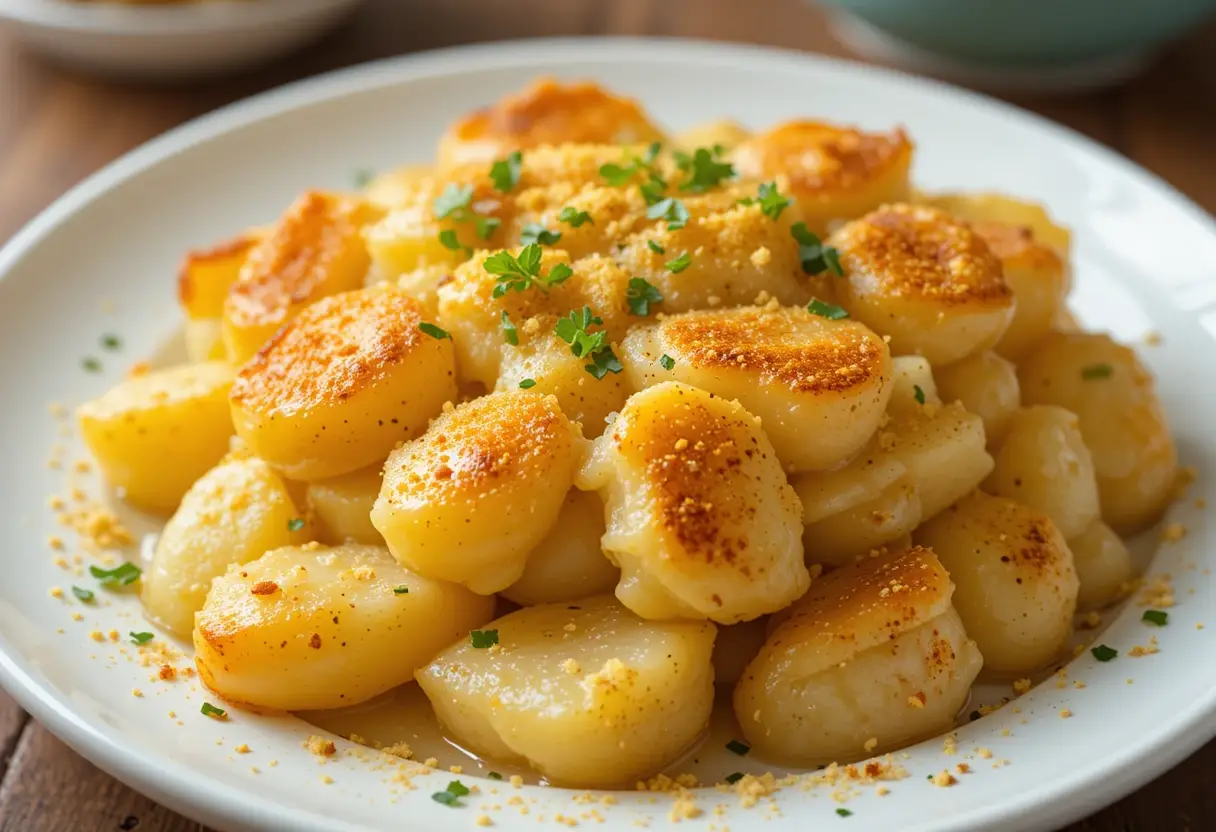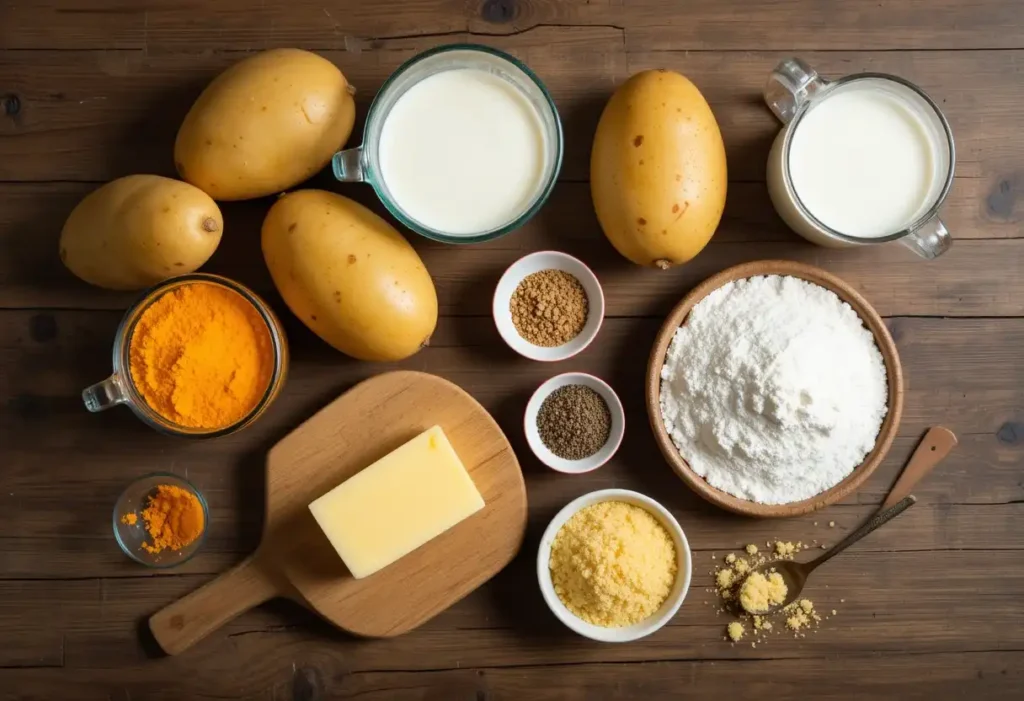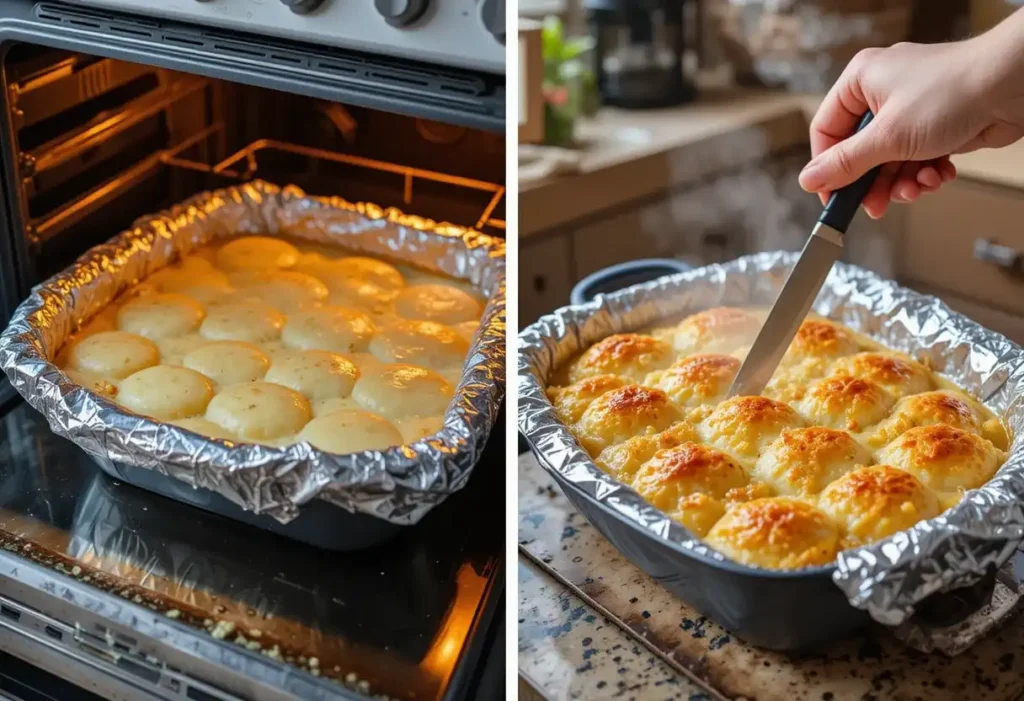Scalloped potatoes are a classic comfort food loved for their creamy texture and rich, indulgent flavor. Originating from traditional European cuisines, these thinly sliced potatoes baked in a luscious sauce are a staple for family dinners, festive occasions, and casual gatherings. Whether served as a side dish or the main event, scalloped potatoes always deliver a hearty, satisfying experience.
Table of contents
Popularity and Variations
The appeal of scalloped potatoes lies in their versatility. While the base recipe includes sliced potatoes, milk or cream, and seasonings, variations abound. You can find recipes incorporating ingredients like onions, garlic, ham, or various cheeses. Some versions use broth for a lighter taste, while others lean heavily into the richness with double cream. Despite regional and personal tweaks, scalloped potatoes remain a universally adored dish.
Importance of Cheese Powder in This Recipe
Cheese powder is a game-changer in elevating traditional scalloped potatoes. Unlike shredded cheese, cheese powder offers a concentrated, even distribution of flavor throughout the dish. It melts seamlessly into the sauce, creating a velvety consistency while delivering a bold, cheesy taste. Plus, cheese powder’s long shelf life and ease of use make it a convenient addition for home cooks. In this recipe, cheese powder enhances the savory profile, making it the ultimate choice for a decadent take on scalloped potatoes.
Ingredients of Scalloped Potatoes Recipe with Cheese Powder
List of Necessary Ingredients
To create the perfect scalloped potatoes with cheese powder, you’ll need the following ingredients:
- Potatoes (4–5 medium-sized): Yukon Gold or Russet potatoes work best for their creamy texture and ability to hold up during baking.
- Cheese powder (1/3 cup): Provides a rich, concentrated cheese flavor.
- Heavy cream (1 cup): Adds creaminess and richness to the dish.
- Whole milk (1 cup): Balances the cream and prevents the sauce from becoming overly heavy.
- Butter (2 tablespoons): For a silky, buttery finish to the sauce.
- Flour (2 tablespoons): Acts as a thickening agent for the cheese sauce.
- Garlic powder (1 teaspoon): Enhances the flavor with a subtle, savory kick.
- Onion powder (1 teaspoon): Adds depth to the dish.
- Salt (to taste): Seasoning to bring out the natural flavors of the ingredients.
- Pepper (to taste): A touch of spice to balance the creamy richness.
- Breadcrumbs (optional, for topping): Creates a crispy golden crust for added texture.
Role of Cheese Powder in Flavor and Texture
Cheese powder is the star ingredient in this recipe, contributing significantly to both flavor and texture. Unlike grated cheese, which can clump or create uneven layers, cheese powder integrates smoothly into the sauce. It delivers a bold, sharp cheese flavor without the need for additional melting steps. Its powdery consistency ensures that every bite of the scalloped potatoes is coated in a uniform, creamy cheese sauce.
Moreover, cheese powder prevents the dish from becoming greasy, a common issue when using high-fat cheeses. This ensures the final result is indulgent yet well-balanced.
Substitutions and Variations
While cheese powder is ideal, there are substitutions and variations to accommodate dietary needs or ingredient availability:
- Cheese Powder Alternatives: If unavailable, use shredded cheddar or Parmesan cheese. Note that this may affect the sauce’s consistency.
- Milk Substitutes: Swap whole milk for plant-based options like almond milk or oat milk for a dairy-free version.
- Gluten-Free Option: Replace flour with a gluten-free thickening agent like cornstarch or arrowroot powder.
- Topping Variations: Add grated cheese or crumbled bacon on top before baking for an extra layer of flavor.
- Flavor Boosters: Incorporate fresh herbs like thyme or rosemary to add a fragrant note.
Step-by-Step Cooking Instructions
Preparing Your Ingredients
- Preheat the Oven: Set your oven to 375°F (190°C) to ensure even baking.
- Prepare the Potatoes: Wash, peel, and thinly slice the potatoes to about 1/8-inch thickness. Use a mandoline slicer for precision and uniformity, which helps with even cooking.
- Measure Your Ingredients: Gather and measure the cheese powder, milk, cream, butter, flour, and seasonings to streamline the cooking process.
- Make the Cheese Sauce:
- In a medium saucepan, melt butter over medium heat.
- Whisk in the flour and cook for 1–2 minutes to create a roux.
- Gradually add the milk and cream, whisking continuously to prevent lumps.
- Once the mixture thickens slightly, add cheese powder, garlic powder, onion powder, salt, and pepper. Stir until the sauce is smooth and creamy.
Layering Techniques for Optimal Texture
- Grease the Baking Dish: Use a light layer of butter or cooking spray on the bottom and sides of a baking dish to prevent sticking.
- First Layer: Arrange a single, slightly overlapping layer of potato slices at the bottom of the dish. Ensure the slices are even for consistent cooking.
- Add Sauce: Spoon a portion of the cheese sauce over the potatoes, ensuring they are evenly coated.
- Repeat Layers: Continue layering potatoes and sauce until all ingredients are used, finishing with a generous layer of sauce on top.
- Optional Topping: If using breadcrumbs or additional grated cheese, sprinkle it over the top layer for a golden, crispy crust.
Baking Time and Temperatures
- Cover and Bake: Cover the dish with aluminum foil and bake in the preheated oven for 40–45 minutes. This step allows the potatoes to soften and absorb the creamy sauce.
- Uncover and Finish Baking: Remove the foil and bake for an additional 15–20 minutes to brown the top. For an extra crispy crust, broil for the last 2–3 minutes, but watch closely to avoid burning.
- Check for Doneness: Insert a knife into the center of the dish; it should glide through the potatoes easily when fully cooked.
- Rest Before Serving: Let the scalloped potatoes rest for 10 minutes after removing them from the oven. This allows the dish to set and makes serving easier.
Tips for Perfect Scalloped Potatoes
Achieving the Perfect Creaminess
- Use the Right Potatoes: Yukon Gold or Russet potatoes are ideal for their ability to absorb liquid and hold their shape during baking.
- Slice Thinly and Evenly: Use a mandoline slicer for uniform slices, ensuring the potatoes cook evenly and maintain a silky texture.
- Layer Wisely: Overlapping the potato slices slightly ensures even cooking while maintaining a cohesive structure.
- Balance the Sauce: The cheese sauce should be thick but pourable. If it’s too thick, whisk in a splash of milk; if too thin, let it simmer longer.
- Cover Initially: Baking the dish covered for the first half traps steam, softening the potatoes and helping the flavors meld together.
Nutritional Information of Scalloped Potatoes with Cheese Powder
Breakdown of Calories and Nutrients
A typical serving of scalloped potatoes with cheese powder (approximately 1 cup) provides:
- Calories: ~250
- Protein: 8g (from cheese powder and milk)
- Carbohydrates: 30g (from potatoes)
- Fat: 12g (from cream, butter, and milk)
- Fiber: 2g (from potatoes)
- Calcium: ~15% of the recommended daily intake (from cheese powder and dairy)
Health Benefits of Key Ingredients
- Potatoes: A rich source of potassium, Vitamin C, and fiber, potatoes are an excellent energy booster and support heart health. For a variation, consider trying mashed potatoes or potato soup.
- Cheese Powder: Known for its concentrated calcium and protein, cheese powder adds robust flavor while supporting bone health and muscle function.
- Milk and Cream: These dairy ingredients provide essential Vitamin D and healthy fats, ideal for energy and bone strength. Explore how milk enhances this cream-based cheesecake recipe.
- Garlic and Onion Powder: These seasonings are not only flavorful but also packed with antioxidants that promote immune health and digestion.
Make Ahead and Storage Tips
How to Prepare This Dish in Advance
Scalloped potatoes can be time-consuming to make, but preparing them ahead can simplify the process:
- Assemble the Dish: Follow the recipe steps up to the baking stage. Layer the potatoes and cheese sauce in the baking dish but do not bake yet.
- Cover and Refrigerate: Wrap the unbaked dish tightly with plastic wrap or foil and refrigerate for up to 24 hours. This gives the flavors time to meld while saving preparation time on the serving day.
- Bake When Needed: Let the dish come to room temperature for 30 minutes before baking. Then bake as directed, adding 10–15 minutes to ensure the dish heats evenly.
For other time-saving recipes, consider vegetarian lasagna soup or a flavorful spaghetti casserole.
Storage and Reheating Instructions
- Refrigeration: Cool the leftover scalloped potatoes completely before storing. Use an airtight container or tightly cover the baking dish with foil. The dish will stay fresh in the refrigerator for up to 3-4 days.
- Freezing: For extended storage, wrap the dish in plastic wrap and aluminum foil, or place portions in freezer-safe containers. Scalloped potatoes can be frozen for up to 3 months.
Reheating Tips:
- Oven: Reheat at 350°F (175°C) for 20–30 minutes, covering with foil to retain moisture.
- Microwave: For smaller portions, microwave on medium power in 1–2 minute intervals. Add a splash of milk or cream to prevent the dish from drying out.
For more inspiration on preserving meals, check out sweet potato-based recipes or learn how to make instant pot yogurt for a versatile side dish.
Storage and Reheating Instructions
- Refrigeration: Cool leftovers completely before storing. Use an airtight container or tightly cover the dish with foil. Refrigerate for up to 3-4 days.
- Freezing: To freeze, wrap the dish in plastic wrap and aluminum foil, or store portions in freezer-safe containers. Scalloped potatoes can be frozen for up to 3 months.
Reheating Options:
- Oven: Reheat at 350°F (175°C) for 20–30 minutes, covered with foil to retain moisture.
- Microwave: For smaller portions, reheat on medium power in 1-2 minute intervals, adding a splash of milk or cream to restore moisture.
For more tips on storing and reheating dishes, visit our guide on meal prep and planning.
Common Mistakes and How to Avoid Them
- Skipping Preheating: Ensure the oven is fully preheated to avoid uneven cooking.
- Using Raw Cheese Powder: Always incorporate cheese powder into the sauce rather than sprinkling it directly onto the potatoes to ensure smooth, even distribution.
- Overcrowding Layers: Thick layers of potatoes can result in uneven cooking. Aim for uniform layering for best results.
- Under-Seasoning: Don’t skimp on salt and pepper-potatoes can absorb a lot of seasoning. Taste the sauce before layering to ensure a flavorful base.
- Skipping Resting Time: Allowing the dish to rest after baking helps it set and prevents a runny texture.
Variations of Scalloped Potatoes
Different Cheeses and Their Impact on Flavor
While cheese powder provides a unique and consistent flavor, experimenting with different cheeses can add variety to your scalloped potatoes:
- Cheddar Cheese: Offers a sharp and tangy taste, ideal for those who love bold flavors.
- Gruyère: Adds a nutty, slightly sweet flavor that complements the creamy sauce beautifully.
- Parmesan: Aged Parmesan delivers a salty, umami kick and pairs well with garlic and herbs.
- Blue Cheese: For a gourmet twist, crumble blue cheese into the sauce for a pungent, complex flavor profile.
- Mozzarella: Provides a milder flavor and a stringy, gooey texture that’s a crowd-pleaser.
Adding Meats or Vegetables for a Complete Meal
Scalloped potatoes can be transformed into a one-dish meal with these tasty additions:
- Meats:
- Ham: Add diced ham between the layers for a smoky, hearty dish.
- Bacon: Sprinkle cooked, crumbled bacon on top for a crispy, savory finish.
- Chicken: Shredded rotisserie chicken or grilled chicken pieces make it a protein-packed meal.
- Vegetables:
- Broccoli: Steam or blanch broccoli florets and layer them with the potatoes for added nutrition.
- Spinach: Add fresh spinach leaves to create a vibrant, nutrient-rich twist.
- Mushrooms: Sautéed mushrooms bring an earthy flavor that complements the creamy sauce.
- Herbs and Seasonings:
- Incorporate fresh herbs like thyme, parsley, or chives for extra flavor.
- A sprinkle of smoked paprika or chili flakes can elevate the dish with a subtle kick.
FAQs about Scalloped Potatoes with Cheese Powder
1. What is the best type of potato to use for scalloped potatoes?
The best types of potatoes for scalloped potatoes are Yukon Gold or Russet potatoes. Yukon Golds have a naturally buttery flavor and hold their shape well, while Russets are starchy and create a creamy texture as they bake.
2. Can I make scalloped potatoes without cheese powder?
Yes, you can substitute cheese powder with shredded cheese like cheddar or Parmesan. However, cheese powder offers a unique convenience and evenly distributes the cheesy flavor throughout the dish.
3. How do I prevent scalloped potatoes from being watery?
To avoid a watery texture:
Use starchy potatoes like Russets.
Cook the sauce until it thickens before layering.
Bake uncovered for the final 15–20 minutes to evaporate excess moisture.
4. Can I freeze scalloped potatoes?
Yes, scalloped potatoes freeze well. To freeze:
Allow the dish to cool completely.
Wrap it tightly in plastic wrap and aluminum foil or store in an airtight container.
Freeze for up to 3 months.
When reheating, thaw in the refrigerator overnight and bake at 350°F (175°C) until warmed through.
5. How can I make scalloped potatoes healthier?
To make a lighter version of scalloped potatoes:
Use low-fat milk instead of heavy cream.
Substitute part of the butter with olive oil.
Add more vegetables like broccoli, spinach, or zucchini to reduce the potato content.
6. Why are my scalloped potatoes still hard after baking?
If your scalloped potatoes are hard, it’s likely due to:
Slices that are too thick. Aim for 1/8-inch slices for even cooking.
Insufficient baking time. Extend the time by 10–15 minutes if needed.
Potatoes not being covered during the initial baking phase. Covering them helps trap steam, softening the potatoes.
Conclusion
Scalloped potatoes with cheese powder offer a creamy, cheesy, and satisfying dish that’s perfect for any occasion. The use of cheese powder elevates the recipe, delivering bold flavor and a velvety texture while simplifying preparation. Whether you serve it as a side dish or enhance it with meats and vegetables for a complete meal, this versatile recipe is sure to impress. With tips for achieving perfect creaminess, storage advice, and exciting variations, you’re now equipped to create a show-stopping dish. So, gather your ingredients, follow the steps, and enjoy the comforting delight of scalloped potatoes made to perfection.
Scalloped Potatoes Recipe with Cheese Powder : Ultimate Guide 2025
Ingredients
- 2 tablespoons unsalted butter
- 1 medium onion finely chopped
- 2 cloves garlic minced
- 1¼ teaspoons salt
- ¼ teaspoon ground black pepper
- 2½ pounds russet potatoes about 5 medium, peeled and thinly sliced (approximately 1/8-inch thick)
- 1 cup low-sodium chicken broth
- 1 cup heavy cream
- 2 bay leaves
- ½ cup cheddar cheese powder
- 1 cup shredded cheddar cheese
Instructions
- Preheat your oven to 425°F (220°C).
- In a large Dutch oven, melt the butter over medium-high heat. Add the chopped onion and cook until softened and lightly browned, about 4 minutes. Stir in the minced garlic, salt, and black pepper; cook for an additional 30 seconds.
- Add the sliced potatoes, chicken broth, heavy cream, and bay leaves to the pot. Bring the mixture to a simmer, then reduce the heat to medium-low, cover, and cook until the potatoes are almost tender, approximately 10 minutes. Remove and discard the bay leaves.
- Stir in the cheddar cheese powder until fully incorporated.
- Transfer the potato mixture to an 8-inch square baking dish or a 1½-quart gratin dish, pressing it into an even layer. Sprinkle the shredded cheddar cheese evenly over the top.
- Bake in the preheated oven until the cream is bubbling around the edges and the top is golden brown, about 15 minutes. Allow the dish to cool for 10 minutes before serving.




